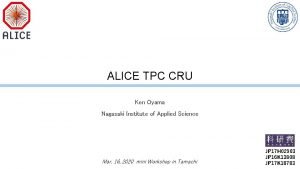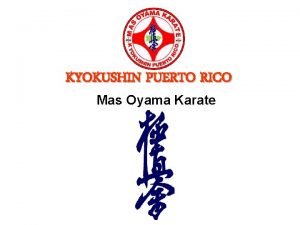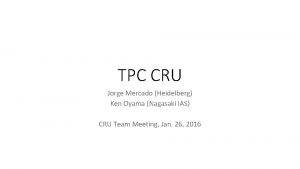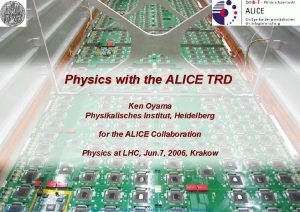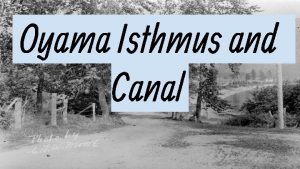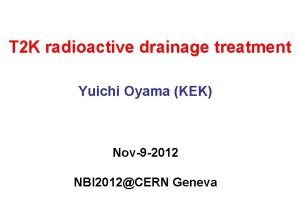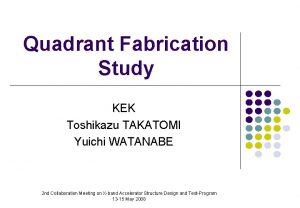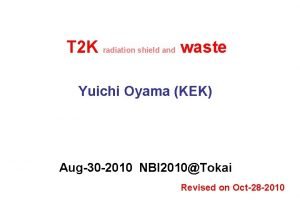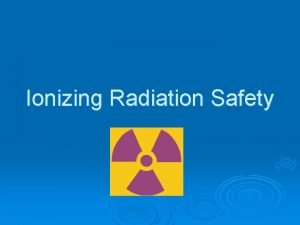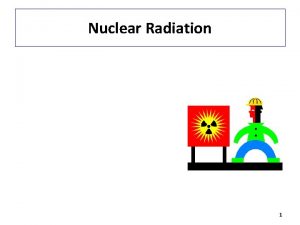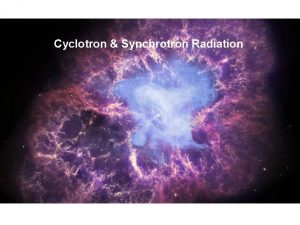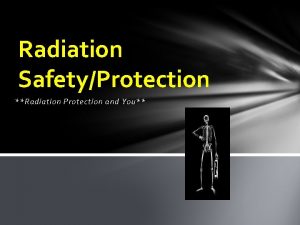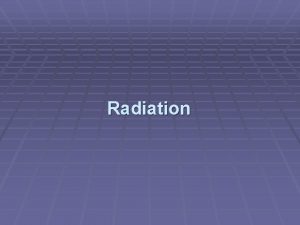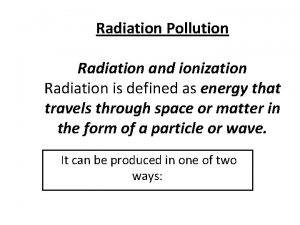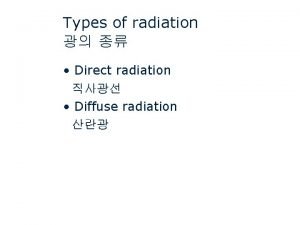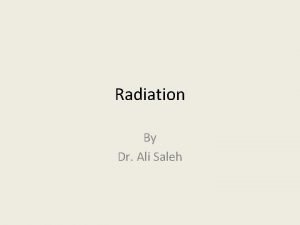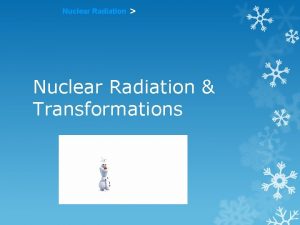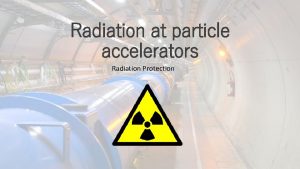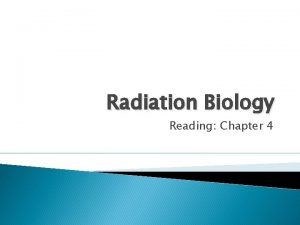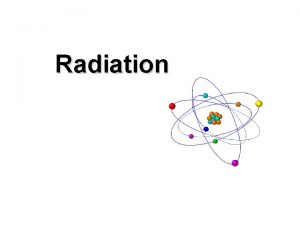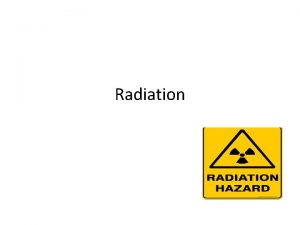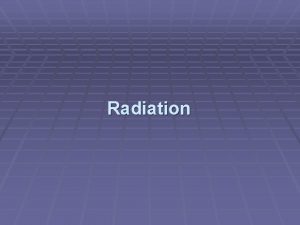KEK Radiation Related Topics Yuichi Oyama KEK for























- Slides: 23

KEK Radiation Related Topics Yuichi Oyama (KEK) for neutrino beam construction subgroup and target monitor subgroup Nov-11 -2003@NBI 2003

Contents (1) Proton beamline (2) Target Station • beam period • after beam stop • maintenance (3) Decay Volume (4) Beam dump / Muon pit (5) Cooling water (6) Air/Helium

Radiations in the Proton ● Beamline Following energy loss are assumed from our experience. Arc Section 1 W/m line loss Preparation Section 0. 75 k. W point loss H < 5 m. Sv/h (line loss) and ● Regulations H < 11 m. Sv/h (point loss) at boundary of the concrete H < 0. 25 m. Sv/h at surface of the Soil Final Focusing 0. 25 k. W point loss Concrete

Example : Shielding around the tunnel ● The thickness of the shielding is calculated by the Moyer’s formula and MARS simulation. 1. 2 m. Sv/h 0. 25 m. Sv/h 11 m. Sv/h 5. 6 m soil 0. 05 m. Sv/h 2. 3 m concrete 6. 2 m soil 2. 5 m concrete 5. 0 m air 2. 5 m air Arc section Final Focusing section

Example : Radiation in the Access Tunnel ● For more complicated geometry, MARS simulation is employed. H~ 0. 5 m. Sv/h ● The graphical view of the calculation shows that the ‘kink’ of the access tunnel effectively reduce the radiation.

Schematic view of the Target 22m Station 33m Surface building 40 tonne crane 11m ground level Concrete service pit Iron Shielding storage of radioactive materials Underground machine room Helium Container Final Focusing section Beam Window Iron Shielding Decay Volume Beam Window Buffle Target, 1 st Horn Concrete 2 nd Horn 3 rd Horn

Radiation during the beam operation Three Regulations must be satisfied. 20 cm Concrete wall (1) H < 12. 5 m. Sv/h@floor of surface building Concrete 4. 5 m fence (3) H < 0. 25 m. Sv/h@out of the control area Iron 1. 5 m Conc 1 m Iron 2. 2 m Iron 1. 5 m Concrete 3. 6 m (2) H < 5 m. Sv/h@boundary of the concrete

Calculation of shielding thickness by MARS ● Instead of 3 D real geometry, virtual cylindrical geometry is used to improve statistics. ● Calculation with 3 D real geometry are in progress for the final confirmation.

Example: floor of the surface building Target station r z With 4. 5 m of concrete above the service pit, radiation at floor of the surface building satisfy H <12. 5 m. Sv/h

Determination of the control area boundary by MCNP ● Neutron sources are defined on the floor, and the dose above the floor is adjusted to be 12. 5 m. Sv/h. Surface building 12. 5 m. Sv/h Top view 0. 25 m. Sv/h ● We need 10 m between the surface building and the fence

Radiation Control Area 低温設 Target Station Control area (class-1) 備 2 nd machine room Control area (class-1) Control area (class-2)

Residual Dose after beam stop After beam stop and ventilation, we must access this area Machine room After 1 year operation and 1 day cooling with 0. 75 MW, the residual dose at the top of the iron shielding is ~0. 1 m. Sv/h We can enter and work in the service pit. Service Pit

Exchange of the target and/or horn ● Open the top of the beamline shielding ● Broken target/horn is highly radioactivated, and must be kept in the storage of radioactive materials for several years. ● The shielding also must be kept in the storage during the exchange Target station : Cross-sectional view Target station : top view storage of radioactive materials

Residual dose of the Target/Horn ● Residual dose of 3 cm. F x 90 cm Carbon Graphite target (in a Al container) and 1 st magnetic horn is calculated. 50 Ge. V 0. 75 MW proton Target Horn (1)(Sv/h) (2)(Sv/h) (1)(Sv/h) 1 day 16. 9 18 18 1 month 11. 6 12. 3 3. 9 1 year 0. 148 0. 16 2. 8 5 year ● 8. 3 x 10 -10 8. 9 x 10 -10 ------ 10 year ------ 0. 25 20 year ------ 1. 7 x 10 -5 After 1 year operation (1)NMTC/JAM(nmtclib 95) + DCHAIN-SP + QAD-CGGP 2 (2)Hadron fluence(MARS) + cross section(9 mb) + 7 Be life Horn must be kept in the storage for more than 10 years.

Residual dose of the Shielding ● Residual dose of the shielding calculated by MARS (1 year operation, 1 day cooling, 0. 75 MW) 0. 1 m. Sv/h Concrete 1 m 22 m. Sv/h 0. 56 Sv/h 0. 65 Sv/h ● ● Iron 2. 2 m Aluminum 0. 2 m Use of Al surface reduce the radiation about one order of magnitude. Further calculation is needed after the “scenario” is fixed.

Requirement for the boundary during the maintenance ● MCNP is used. g-ray source are defined on the Al tunnel surface. 0. 75 MW 1 -year operation, 1 -day cooling Open the shielding 3 m 0. 25 m. Sv/h 0. 4 Sv/h ● Radiation from residual dose in the tunnel is satisfactory small.

Calculation of As the target station, virtual cylindrical geometry is used in the MARS calculation. 30 -40 m downstream of target station log(H(m. Sv/particle)) ● Decay Volume Shielding 5 m. Sv/h 5. 5 m He Concrete thickness (m) ● 5. 0~ 5. 9 m of concrete and additional ~ 6 m of soil are needed to satisfy concrete and soil surface condition

Radiation behind the Beam ● ● Dump At the muon pit, muons from p→nm must be measured with energy threshold of 2~ 5 Ge. V to study neutrino property. Copper 1. 5 m + Iron 1. 5 m + concrete 0. 5 m satisfy this requiremen The threshold for the muons is Eth~ 4. 5 Ge. V The residual dose in the muon pit(30 days beam, 1 day cooling, 0. 75 MW) is 0. 2 m. Sv/h. We can enter the muon pit after the beam stop.

Management of Cooling Water ● Regulation : Radioactive water can be exhausted to outside (ocean) if radioactivity is less than 15 Bq/cc. ● Radioactive primary cooling water is circulated only in the underground control area during the beam period. To 2 nd machine building Heat exchange Primary cooling water system Secondary cooling water system Third cooling water system Target/Horn cooling

Disposal Scenario of Radioactive Water ● After 20 days operation, the all radioactive water is transferred to a DP tank in the disposal system. The cooling system for the decay volume is used for this purpose (to save money). ● They are mixed with fresh water in the dilution tank. TS underground machine room Beam Dump machine room Decay Volume Heat exchange Primary cooling water from Target/Horn ● Heat exchange Primary cooling water from Beam Dump After measurement of radioactivity in the dilution tank, the water can be disposed. It takes 1 or 2 days for the measurement. DP tank Fresh water Dilution tank Disposal line

Summary of cooling water and their radio-activation 0. 75 MW , 20 days operation component Norm. Cond. Mag. Total 3 H (GBq) 15 Bq/cc equiv. Vol. (m 3) 30000 ------ 0. 07 5 1 100 8 x 10 -3 2. 3 150 ------ 200 x 3 ------ 1. 0 x 3 66 x 3 Target Station 55 ------ 4 x 10 -5 0. 63 42 Decay Volume 1100 ------ 1 x 10 -5 3. 3 220 13 ------ 1 x 10 -5 0. 04 2. 6 Horn x 3 Beam Dump ● Neutron fluence (/cm 2/p) ------ Target ● Water in the beam- the system line (liter) We need a capacity of ~ 600 m 3 to dispose all together. If we make 60 m 3 dilution tank, we must repeat the dilutions 10 times. We must also consider a possibility to confine the primary cooling water in the radiation control area forever.

Ventilation of Air and Helium ● Regulation : Radioactive gas (air/Helium) can be ventilated to environment if radioactivity is less than 5 m. Bq/cc. ● Air in the low radioactivity area (e. g. surface building) is always ventilated even during the beam period. ● High radioactivity area (e. g. underground control area) is closed in the beam period. After the beam stop, high radioactive air/Helium must be mixed with fresh air and ventilated gradually if the radioactivity exceed 5 m. Bq/cc.

Summary of Air/Helium and their radio-activation 0. 75 MW , 20 days operation sair=30 mb, s. He=1. 2 mb, Ventilation : 8000 m 3/h, < 5 m. Bq/cc volume (m 3) Neutron fluence (/p/cm 2) Surface building 8000 1 10 -19 4 10 -14 8000 A 1 Service pit 230 5 10 -12 2 10 -6 230 B 0. 03 U. g. machine room 330 5 10 -12 2 10 -6 330 B 0. 04 radioactive storage 780 5 10 -12 2 10 -6 780 B 0. 1 Iron cooling (out)? 38 1 10 -10 4 10 -5 38 B 0. 005 Iron cooling (cent)? 33 1 10 -8 4 10 -3 33 B? 0. 004 Iron cooling (in)? 28 2 10 -5 8 44800 C 5. 6 TS Helium (air) 135 2 10 -4 3. 2 (80) 86400 C 10. 8(270) component Radio 5 m. Bq/cc Ventilatio activatio equiv. Vol. tilati n time(h) n(Bq/cc) (m 3) on DV Helium (air) 1600 5 10 -5 0. 8 (20) 256000 C A : Ventilate during beam period; B : Ventilate directly after beam stop C : Ventilate by mixing with fresh air after beam stop 32(800)
 Kék sárga kék zászló
Kék sárga kék zászló Oyama arisu
Oyama arisu Dojo kun oracion
Dojo kun oracion Ken oyama
Ken oyama Trdken
Trdken Fitness related images
Fitness related images Two types of physical
Two types of physical Datorkunskap för nybörjare
Datorkunskap för nybörjare Fredsgudinna
Fredsgudinna Steg för steg rita
Steg för steg rita Ministerstyre för och nackdelar
Ministerstyre för och nackdelar Nationell inriktning för artificiell intelligens
Nationell inriktning för artificiell intelligens Bästa kameran för astrofoto
Bästa kameran för astrofoto Tillitsbaserad ledning
Tillitsbaserad ledning Bat mitza
Bat mitza Sju för caesar
Sju för caesar Vad är prosa
Vad är prosa Nyckelkompetenser för livslångt lärande
Nyckelkompetenser för livslångt lärande Datumr
Datumr Orubbliga rättigheter
Orubbliga rättigheter Borstål, egenskaper
Borstål, egenskaper Big brother rösta
Big brother rösta Särskild löneskatt för pensionskostnader
Särskild löneskatt för pensionskostnader Verktyg för automatisering av utbetalningar
Verktyg för automatisering av utbetalningar

